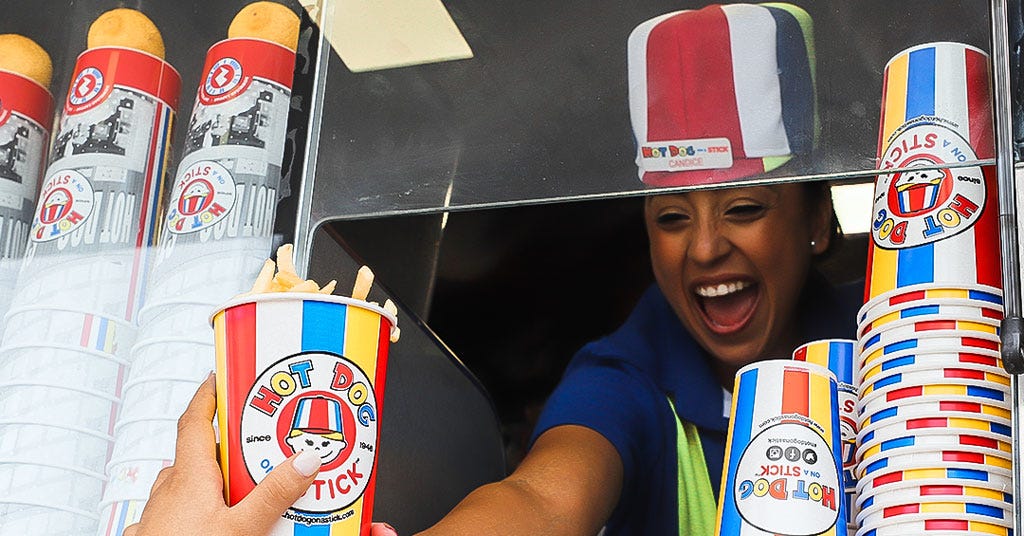Is there a chain restaurant - or local fast food spot - that represents summer to you? I can’t remember the place, but I know Green River Soda was a big highlight for me as a kid. (And I didn’t even know it was only sold in Seattle at the time!) Please enjoy these stories by Hannah Borenstein and Sasha Weilbaker. -Katherine

Where Corn Dogs Are Hot Dogs
By Hannah Borenstein
When I attended a state fair for the first time, in my 20s in Raleigh, North Carolina, I was sensorily transported to a San Francisco mall. The smell of fair food in the southeast harkening fond childhood memories of an indoor galleria in the Bay Area seemed unlikely, but as others who experienced childhood in the California ‘90s know well, the visual and olfactory allure of Hot Dog on a Stick never really goes away.
The franchise, which sounds like the stuff of lazy satire – a name SNL might use to parody American food consumption – enticed me and my brothers to behave so that we could indulge in their staples: deep-fried corn dogs and saccharine lemonade.
Most credit the introduction of corn dogs to U.S. culinary culture to German immigrants in Texas, who began settling in the 1800s with the establishment of the Adelsverein, a weak colonial attempt to establish a German settlement in the Republic of Texas. They knew how to make sausages well, but learned they would need to coat them in a fried corn batter to better serve local palates. There is evidence from patent 1706491 – filed in 1927 and issued in 1929 – that contraptions to bake “korn dogs” were in wholesale catalogues earlier, but they did not gain significant popularity until the early 1940s. There are some disputes as to whether or not the delicacy’s popularity is thanks to the Texas State Fair or amusement parks on the Oregon coast. Regardless, a few years later, they had taken the U.S. state fair scene by storm.
Dave Barham, who grew up on a Missouri farm, was introduced to the corn dogs at fairs while he began travelling as an entrepreneur and wanted to bring the idea to California. Barham opened the first Hot Dog on a Stick in 1946 in Santa Monica, California. He first named the treat Party Puffs, and used his mother’s corn bread recipe to coat the dogs, then changed the name to Hot Dog on a Stick when he took the product on the road. First, he went to county fairs, and then to shopping malls, long before the food court was an established phenomenon.
Even as Hot Dog on a Stick franchised, became a food court staple along the west coast, and went international, its aesthetic remained largely unchanged. Employees wear red, white, blue and yellow striped shirts, with matching hats (that they’re not allowed to take home), so even if the aroma doesn’t take you back, the visuals sure will.
Hotdish with Kristen Meinzer
Yes, it's one word - because it's one word in Swedish, too.
Listen to Smart Mouth: iTunes • Google Podcasts • Stitcher • Spotify • RadioPublic • TuneIn • Libsyn • Amazon Music

Northern Vermont’s Summer Treat
By Sasha Weilbaker
After moving to Northern Vermont from the Bay Area last spring, I wasn’t surprised to see what appeared to be ice cream stands opening around my new town of Burlington as the weather turned warmer. The city, which runs parallel to Lake Champlain, draws in crowds from all over New England (and beyond) for classic summer fun, usually involving an ice cream cone at the end of the day.
However, what was surprising were the large signs above each stand that read CREEMEE. I wondered to myself if this “creemee” was different from soft serve…and if so, how?
While the specific history of the creemee is, unfortunately, hazy, it’s clear that creemees evolved with the development of soft serve ice cream, the origin of which is also unclear. Whether soft serve was created by Thomas Carvel in 1934, Dairy Queen in 1938, or someone else entirely, the dessert, which Hello Burlington describes as “ice cream pumped through a machine to make it more airy and soft” certainly took off in the late 1930s.
But, this leaves the question, “how are creemees different from soft serve?” still up for debate. Many say that ice cream stands in Vermont sold soft serve with a higher butterfat content, making it taste “creamier” than traditional soft serve. While this has yet to be proven, it certainly makes for a good story.
Once creemees became a Vermont summer staple, it didn’t take long for a maple iteration to hit the market. Today, maple creemees are considered a Northern Vermont summer classic. Vermonters and tourists alike can be found with a maple creemee in hand whether down by the lake or in the Green Mountains.
For those not sold on the maple creemee, never fear, classic chocolate and vanilla flavors are still just as popular.
If you find yourself visiting Northern Vermont in the summer, grab a creemee at Burlington Bay Market and Cafe or Little Gordo Creemee Stand in Burlington, the Village Creemee Stand in Bristol, Morse Farm Maple Sugarworks in Montpelier, or Palmer Lane Maple in Jericho.
 Tiktok failed to load.
Tiktok failed to load.Enable 3rd party cookies or use another browser
If you liked the newsletter today, please forward it to someone who’d enjoy it, and tap the heart icon above or below, which will help me reach more readers. I appreciate your help, y’all!
This newsletter is edited by Katherine Spiers, host of the podcast Smart Mouth.
A TableCakes Production.
Want to contribute? Here are the submission guidelines.





